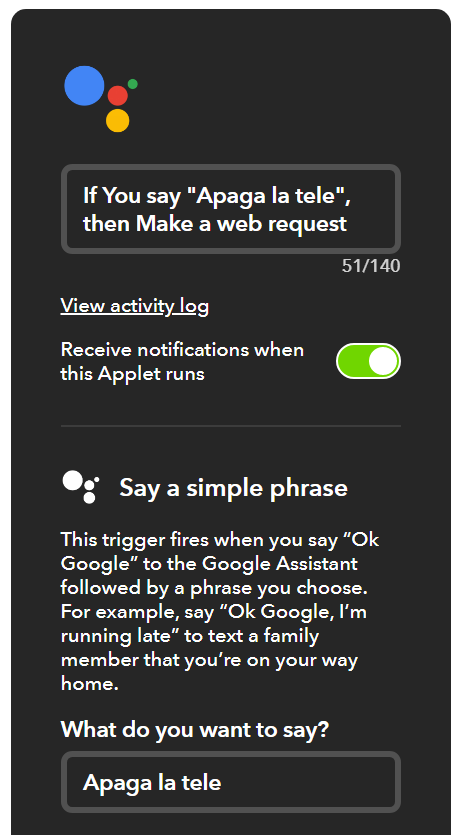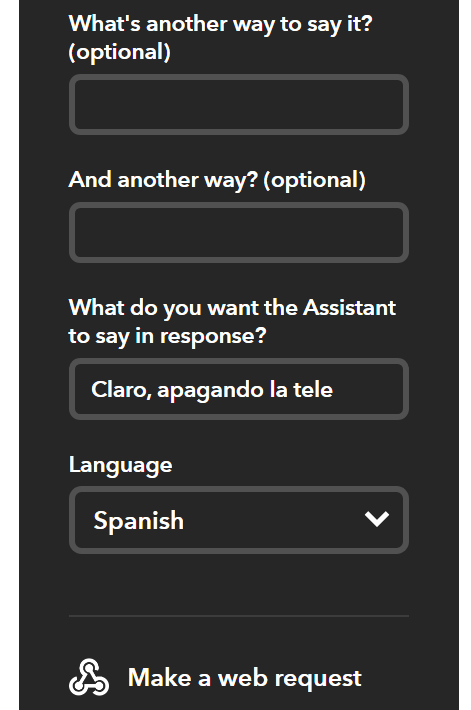I’d would be really nice if I could use IFTTT with Blynk,
Then I could make thinks like “if I am home turn button X on”
Or something…
IFTTT already has Phillips hue support, and I’d be nice if I could control my led strips, etc with it.
Done.
How do I use it?
It doesn’t show up as an applet in “that” when making a new IFTTT…
thanks for the quick response
Search.
There are lots of tutorials on the forum. You’re going to use Web hooks to interface IFTTT with Blynk.
Hi i am trying all morning to hook up a NodeMCU to IFTT using webhooks with no luck.I wanna issue a voice command through Google assistant such as “arm home” which is straight-forward then use webhooks to send a web request.The ping for the Blynk ip is 139.59.206.133.So on webhooks i should type something like http://139.59.206.133/MY BLYNK TOKEN/update/D0 as i want to blink the in-build led of the NodeMCU for testing purposes.Then method PUT --> content type application/json.At last body should be “1” [“1”] or plain 1 ???as i want to be HIGH to light the led.Also should the blynk sketch should involve some coding other than the standard one (meaning blynk token,ssid and pass).Thank you all.
@Conktr I’m glad this rather long thread has the potential to help other Blynkers and not just the OP.
All the info you require is in this thread but to summarise:
Forget PUT, Blynk has a GET call that does a PUT.
GET doesn’t require a body.
Try with port 8080 if default http of 80 doesn’t work
Ensure require ports are forwarded for WAN access, I would do 80, 8080, 8441, 8442 and 8443 (forget https)
Syntax for GET (normally considered a PUT) is:
http://IP_ADDRESS:8080/TOKEN/update/pin?value=1
See https://blynkapi.docs.apiary.io/#reference/0/write-pin-value-via-get/write-pin-value-via-get
Edit: sorry I thought you were posting on this recent thread Blynk Local server + IFTTT
Once again Costas thanks again for the reply. So the syntax on IFTTT is as you mentioned?
The syntax is shown in my post and to send an ON signal for you it would be:
http://139.59.206.133/MY BLYNK TOKEN/update/D0?value=1
or
http://139.59.206.133:8080/MY BLYNK TOKEN/update/D0?value=1
Just change the final 1 to 0 to send OFF signal.
Just remember “D0” in the url is GPIO 0 not the silly “D” references on many ESP development boards as they are nothing to do with GPIO numbers.
I have managed to make it work. the problem was the silly gpio pinout.MAN YOU ARE THE BEST.Now i have a fully functioning voice controlled alarm system using a simple circuit and the programmable outputs of the system itself i can arm /disarm and see the system state from my phone.Blynk is the best app ( by far) i have used and the community is the best.
i am facing the almost same problem, i am using a local server. normal http or https requests works from browser as formatted above. but still i cant make a IFTTT request… using google assistant + webhooks ( on the cloud server it worked perfectly and , definitely changed all needed items to run on local server )… so more help would be greater
Hi @FavasKhan,
I’m using Google assistant and IFTTT + local server with no issues. Once at home I will share my set-up.
Regards
Thankz in advance …
i forgot to mension this earlier that i am running my local server on windows 10 running laptop. and using wifi for data
What sort of Dynamic DNS service are you using (assuming that your ISP doesn’t provide a static public IP)?
What port forwarding have you set-up on your router, and what IFTTT command are you using?
Pete.
i am using web-hooks to forward the below URL request
http:// ip:8080/key/update/D2?value=1
https:// ip:9443/key/update/D2?value=1
i am using my smartphone hotspot and … definitly it can create a static ip.
(the command works if i use this on direct url in browser, and i also tried used both static ip and and system ip. . and tried http and https everything worked in direct command mode from browser)
the command actually works when i try to put it directly on browser’s address bar. the problem i face is really from the ifttt webhook forwording…
could you please explain me … or put a screen shot of your applet … that would be a great help. and make sure you blur the essential …



once again thanks for the time you took to consider thiss…
I think the problem you’re having is that when you issue the command from a browser within your own network, the command can be seen by your local server, because its on the same network.None of this traffic is travelling across the internet, its simply being routed within your own network.
For IFTT to be able to resolve your local server, it needs to know your public IP address, AND, the traffic that is sent to that IP address needs to be routed to the correct device - in this case your laptop. For that to happen, your router needs to be told that whenever traffic arrives from the WAN port (the internet) on port xxxx, route it to this IP address within the network.
From your description of your setup it doesn’t sound as if that’s how you have your network configured.
Pete.



